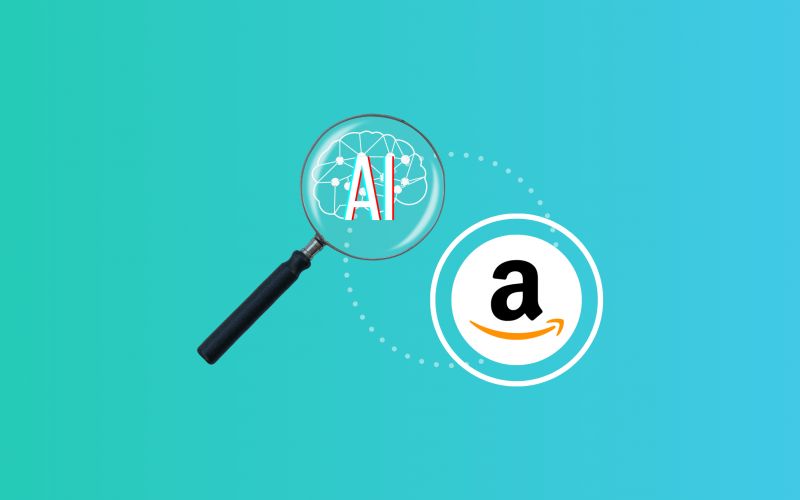Amazon has established itself as a dominant force in the ecommerce industry. Initially serving as a platform for selling books, it’s since evolved into an unmatched marketplace where millions of individuals browse and buy millions of products every day. A key factor contributing to Amazon’s success is its exceptional utilization of artificial intelligence (AI) and automation. These cutting-edge technologies have revolutionized the user experience and fundamentally transformed the ecommerce industry.
Today, we’ll delve into how Amazon’s implementation of AI has propelled it to the forefront of ecommerce and what other innovative strategies it offers ecommerce sellers.
Contents:
1. Amazon’s AI integration for improved search experience
2. Amazon’s AI strategies to enhance customer experience and sales
3. AI in sales forecasting, inventory management, and supply chain optimization
4. How does Amazon’s AI integration empower Amazon sellers?
Amazon’s AI integration for improved search experience
Let’s start with the recent news. Amazon’s relentless commitment to customer-centric innovation is evident in its latest foray into AI integration for search.
Drawing inspiration from the resounding success of ChatGPT’s clean and user-friendly design, Amazon is poised to introduce a transformative and interactive conversational experience to its vast user base. This strategic move showcases Amazon’s dedication to staying at the cutting edge of technology, competing with industry titans like Google and Microsoft in the fiercely contested digital search grounds.

Potential benefits of Amazon AI search
At this point, Amazon might drastically ameliorate the traditional search process, making customers’ online shopping journeys more personalized, intuitive, and rewarding. This new feature might help customers find product answers, compare products on the go, and receive personalized product suggestions – like, everything that might help them purchase on Amazon more efficiently.
What’s the catch for Amazon? Quite obviously, people would buy more on the platform, which is a 360-degree win-win for everyone: customers, sellers, and Amazon.
Let’s break it down.
Improved customer satisfaction and loyalty
Amazon anticipates a significant effect on customer satisfaction and loyalty. They create a conversational experience similar to talking with a well-informed sales associate, which fosters closer connections between customers and products. The improved search interface will enable shoppers to make informed decisions, instilling trust and confidence in their purchases. This increased engagement is highly likely to result in better customer retention and repeat business for ecommerce companies that sell their products on Amazon’s platform.
Better sales strategies
Moreover, as the ChatGPT-like bot gathers more data on customer preferences and behaviors, it’ll continually refine its recommendations, making the search experience even more accurate and relevant over time. This iterative learning process will empower businesses to optimize their product offerings and marketing strategies, aligning with evolving consumer demands and preferences.
Growth opportunity for businesses
For smaller businesses and emerging sellers, this integration holds the potential to level the playing field in the competitive ecommerce ecosystem. By tapping into Amazon’s AI-powered search capabilities, these sellers can showcase their products more compellingly, reaching a broader audience that might have previously eluded them. As AI guides users toward personalized product suggestions, these businesses can seize the opportunity to capture new customers and expand their market presence.
More benefits to ecommerce customers
As Amazon strengthens its position in the AI-driven ecommerce landscape, some industry players might feel the pressure of increased competition. Rival platforms and online marketplaces might want to adapt swiftly, innovating their search experiences to offer features that match or surpass Amazon’s advancements. This escalating competition will, at the end of the day, benefit consumers as different platforms strive to enhance user interfaces, tailor product recommendations, and elevate the overall shopping experience.
As you can see, Amazon’s AI integration into the search interface might disrupt the shopping experience, setting the search standards to new heights. And while it might help Amazon secure its position as an industry leader, it also presents unprecedented opportunities for ecommerce businesses and customers.
However, it’s not the only way Amazon embraces AI. You might be surprised in how many ways it actually applies AI to improve its services within the ecommerce grounds. So, make yourself comfortable with a nice cup of tea (or probably a lemonade might be just as good) and we’ll proceed.
Amazon’s AI strategies to enhance customer experience and sales
As previously stated, Amazon’s upcoming AI search will provide personalized product recommendations. However, it’s important to note that Amazon has implemented AI-powered product suggestions for quite a while now, striving for a better user experience. Besides, they’ve been using AI-powered chatbots to enhance customer satisfaction and increase sales, ultimately improving Amazon’s online shopping experience.
Let’s look at these tools in more detail to see how they work and what makes them beneficial.

Product recommendations
Amazon’s marketing strength lies in its product recommendations. AI algorithms allow the company to quickly and accurately analyze vast volumes of customer data. Every customer interaction, including previous purchases, viewed products, and conducted searches, is carefully studied to understand individual preferences, interests, and behavior. With this valuable information, Amazon creates a personalized list of recommended products for each customer, which seamlessly accompanies their shopping experience.
The effect of personalized product recommendations on customer behavior is impressive. Amazon guides customers towards relevant and complementary items, encouraging them to explore additional options and leading to increased sales and larger shopping carts. This proactive approach subtly influences customers’ purchasing decisions, facilitating the discovery of products they may not have otherwise considered. This way, Amazon’s ability to anticipate customer needs and provide a curated shopping experience has made it a leader in the ecommerce industry.
AI-powered chatbots
In addition, Amazon has been widely using chatbots to revolutionize customer communication. These AI-powered virtual assistants offer invaluable support, facilitating two-way interactions with customers and transforming the approach to customer support. They handle common questions and assist with catalog browsing, providing instant responses, 24/7 availability, and personalized assistance, enhancing the customer journey and making the experience even better.
There are many advantages to using chatbots in Amazon’s customer service approach. The most significant benefit is that they can provide quick, relevant responses to customer questions, making their shopping experience smoother. As today people expect immediate answers, it can be pretty helpful. Additionally, chatbots can manage multiple inquiries at the same time, reducing the workload on human support staff and improving the entire support process.
In addition, chatbots improve their responses and problem-solving skills by learning from their interactions with customers, providing more personalized and accurate support over time. This flexibility enhances the customer experience and increases satisfaction and loyalty, building a strong relationship between the brand and the consumer.
Besides, chatbots can act as proactive guides by offering real-time personalized product recommendations. Based on customers’ preferences, buying history, and browsing behavior, they can suggest products that match customers’ unique tastes and requirements. This proactive approach increases customer engagement, encourages exploration of additional products, and ultimately boosts sales and customer loyalty.
AI in sales forecasting, inventory management, and supply chain optimization
Amazon’s known for its remarkable ability to manage a wide-ranging inventory and deliver products quickly. The company effectively balances stocking enough products without having excess inventory. They achieve it by integrating AI technologies into their sales forecasting and inventory management processes.

Amazon uses AI-powered sales forecasting as the core of its inventory management strategy. Behind it are complex algorithms and machine learning techniques that help analyze multiple data points, including historical sales data, customer behavior, seasonal trends, and external factors, such as weather patterns and marketing campaigns. The AI algorithms usually consider numerous variables to generate precise demand forecasts for various product categories. This way, Amazon can predict changes in demand based on patterns and trends from past data and adjust its inventory levels accordingly.
A prime example of Amazon’s effective AI-driven inventory management is its approach to handling seasonal products. Seasonal items, like holiday decorations or summer-related merchandise, experience significant fluctuations in demand throughout the year. AI-powered systems can accurately predict when these items will be in high demand and when the demand tapers off. As a result, Amazon can adjust inventory levels to avoid stockouts during peak seasons and prevent overstocking when the demand dwindles.
Let’s look at other technologies that help Amazon maintain effective and efficient inventory management.
Improving inventory management through image recognition
Amazon has dramatically improved inventory management capabilities using image recognition technology. AI systems can quickly and accurately categorize products through visual analysis, enabling precise tracking of inventory levels. This advancement is powered by sophisticated image classification algorithms, which help in identifying and sorting items based on their visual characteristics, ensuring that inventory is managed efficiently and accurately.
For example, at Amazon’s fulfillment centers, AI-powered cameras can quickly scan and identify new shipments, automatically updating inventory. This real-time tracking ensures accurate product availability on the website, avoiding overselling or stockouts.
Utilizing deep learning to recognize trends and patterns
Amazon uses deep learning techniques to analyze intricate customer behavior patterns, including purchasing history and preferences. Then it utilizes this data to make informed inventory decisions.
For example, an AI algorithm identifies that certain products often sell together as part of a bundle. At this point, Amazon can package and stock these items together, streamlining the fulfillment process and enhancing the customer experience.
Natural language processing to learn customers’ sentiments and preferences
Natural language processing (NLP) is another technology Amazon uses for better inventory management. NLP enables the system to analyze and interpret textual data, including customer reviews, feedback, and product descriptions. These insights into customer sentiments and preferences help Amazon make data-driven decisions on which products to prioritize and stock in its inventory.
It’s evident that Amazon improved their supply chain and exceeded customer expectations using AI-powered sales forecasting and inventory management. Thanks to this data-driven approach, products are now readily available in nearby fulfillment centers, resulting in shorter shipping times and distance traveled for each delivery. As a result, Amazon can ensure timely deliveries and provide an enhanced customer experience.
How does Amazon’s AI integration empower Amazon sellers?
We have discussed how AI integration helps Amazon constantly enhance the customer journey, which makes the marketplace keep the leading position on ecommerce grounds. It’s only fair if we change our focus now and consider the perspective of the merchants who use Amazon as their virtual marketplace.
What are the advantages of Amazon’s AI integration for sellers? How can it benefit entrepreneurs who are trying to navigate this marketplace?
Let’s find out.
Are you selling on Amazon and other marketplaces? Integrate Amazon with accounting and other sales channels to have a 360-degree view of your sales, automated bookkeeping, accurate reporting, and real-time insights into your ecommerce business performance. Ask the Synder team how to easily make sense of your ecommerce numbers. Book a seat at our free webinar or sign up for a free trial to explore Synder yourself.
Leveraging data-driven insights
Amazon’s AI integration provides valuable insights through a vast collection of data. Sellers can access consumer behavior data to uncover emerging trends and popular products and anticipate market demand. Using advanced algorithms, sellers can strategically align their inventories and optimize product offerings for a competitive edge in the ecommerce landscape. If Amazon does it, why can’t you?
Fostering cross-selling opportunities
Amazon’s product recommendation system, powered by AI, has proven value for sellers, positively affecting customer satisfaction and revenue streams. As customers peruse the vast selection of products, the algorithms provide expert suggestions for complementary items, enticing them to consider additional purchases. For sellers, this translates to more cross-selling opportunities and the ability to leverage the benefits of personalized shopping experiences.
Navigating the pricing dynamics
Sellers on Amazon can benefit from using AI-powered dynamic pricing strategies to respond to changes in the market promptly. This way, they can increase their competitiveness and get a better chance of winning the Buy Box. By adjusting their prices in real-time, sellers can attract more customers and improve their sales performance.
Managing inventory wiser
AI-powered predictive analytics helps sellers optimize inventory management processes (just like it does for Amazon). As mentioned above, the AI system analyzes historical data and provides actionable demand predictions, allowing sellers to stock inventory proactively and avoid costly stockouts. Sellers end up with increased customer satisfaction, which fosters trust and contributes to long-term success in the competitive ecommerce grounds.
Targeting the right audience
Amazon’s AI integration also extends its benevolence to sellers by optimizing their advertising efforts. Machine-learning algorithms drive targeted advertising campaigns, enabling sellers to reach their most relevant audience segments. With improved visibility and increased brand awareness, sellers can maximize the efficiency of their marketing spend and propel their businesses toward sustainable growth and prosperity.
So, as we mentioned before, and it’s worth repeating, Amazon AI integration is an example of how technology can be a win-win in the ecommerce industry, benefiting all the involved parties – the marketplace, its customers, and sellers.
Bottom line
As you can see, Amazon’s extensive use of AI technology has propelled it to the forefront of ecommerce. The forthcoming AI integration for search exemplifies its commitment to enhancing the user experience for customers and sellers alike. By offering personalized, intuitive search results and product recommendations, Amazon aims to foster customer satisfaction and loyalty while empowering sellers to optimize their offerings. As the ecommerce landscape evolves, Amazon’s AI-driven strategies set new standards and present unprecedented opportunities for all involved parties, making technology a clear win-win solution in the industry.

.png)




